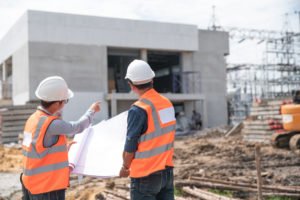HSE Director at Jacobs, Sukhy Hogwood, talks to SHP about safety in design and her role in ensuring buildings are not only safe to construct, but also usable for those who will be living, working in, and recreationally using the space.
 Sukhy began her career 20 years ago as a safety graduate, before working in roles in nuclear and construction. For the last three years, she has been at Jacobs, where she has recently been appointed Head of Safety for Europe.
Sukhy began her career 20 years ago as a safety graduate, before working in roles in nuclear and construction. For the last three years, she has been at Jacobs, where she has recently been appointed Head of Safety for Europe.
“Jacobs is a design and engineering organisation and part of why I was brought back into the company was to really reinvigorate our approach to safety in design, not just in the UK where we’ve got plenty of legislation, but to take that approach globally.”
Sukhy has spent the last three years developing, implementing, and communicating out a whole new ethos when it comes to safety and design. That includes arrangements, governance, training, but it’s also been a marketing and brand campaign, to convey the importance of safety in design and to get people excited about it.
Click here to listen to this interview in full…
“What we’ve tried to do is make people understand that the design phase, or the planning phase, is the whole reason for being in safety. We must bring it more into the spotlight, it must be made better. We’ve got the usual arrangements that you see replicated around industry, we’re trying to digitise processes and we’re trying to make sure our compliance pieces right, but what we perhaps fail to portray as a profession, is capturing of the hearts and minds of designers.”
A lot of the work Sukhy does is about highlighting the expertise within the engineering community and the impact of decisions that are made at the design stage. “Yes, an amazing structure might win an architectural, engineering or construction awards, but somebody has to then go and build it. People have to be able to use it. Someone with a family has to drive their car over that bridge. That’s the bit that we want our designers to start thinking about. Any decision that they’re taking is to is to capture the safety behaviours and to capture the impact that they’re going to make, the people that they could affect and how and how they can prevent accidents from happening.”
The idea is to put the power in the designers’ hands to get everything right on site and the rest of our safety boards don’t necessarily have to do much, because it’s already been done. “That’s what our safety in design ethos is built around now. We’ve called it ‘Five in De5ign’ and we’ve got five steps that we want people to capture.”
Make it easy for everyone
Be curious about what you have to offer – Knowing that curiosity empowers innovation, and it powers collaborative thinking. We want our designers to be curious, think about how we’ve done things 20 years ago, how we’re doing things now and how we want to see things being done in the future. And that includes obviously the safety side, keeping people safe and well and healthy. But then the synergies that go along with that in terms of inclusivity and diversity and sustainability.
- Select the best option – Getting to the technical elements and understanding its stakeholders, clients, neighbours and ensure, right at the outset of designs, that you’re taking the right decisions.
- Record, learn from and share your performance – Which, let’s be honest, as an industry we don’t do very well. If a bridge designer in the US learns a lesson, does anybody in the Middle East find out about it?
- Identify, record and communicate – The meat of what safety in design is, the risk assessment side which safety professionals know like the back of their hand.
- Make it easy for everyone – The idea that we can do create added simplicity during the during the design phase is fundamental. We don’t want to give people more processes in PPE and training. We want to make it easy, want to give them technical advancements and innovations.
“We want to make it easy by talking and laying out contractual landscapes that allow people to talk to one another, that allow our contractors to challenge a client, to challenge a designer, to work together to get a good solution.”
The most inclusive work environments are the safest work environments
 “There was a McKinsey article, written about 10 or 15 years ago, that said ‘the most inclusive work environments are the safest work environments,’ because people are looking out for one another, asking ‘are you OK?’, ‘can I do anything differently for you?’, because you felt looked after. There is an adage of your brother’s keeper looking over your shoulder and making sure you’re ok. Inclusive environments tend to do that.
“There was a McKinsey article, written about 10 or 15 years ago, that said ‘the most inclusive work environments are the safest work environments,’ because people are looking out for one another, asking ‘are you OK?’, ‘can I do anything differently for you?’, because you felt looked after. There is an adage of your brother’s keeper looking over your shoulder and making sure you’re ok. Inclusive environments tend to do that.
“We must start considering the inclusivity piece of this. One of the things we’re working on is a is an initiative called Fearless streets and places. At Jacobs, we do a lot of urban work, and there has obviously been several horrendous events in the news recently, with Sarah Everard, Sabina Nessa and Ashling Murphy. These women were just going about their business and were killed. The killings bought a whole piece about how we can prevent violence against women. Yes, there is the cultural and educational aspect, but can we design our cityscapes so that they’re a lot safer for anyone to walk in? At the design phase, can we consider areas where there may be shadows and avoid inadvertently creating places that people can hide in? Can we create spaces that make people feel comfortable and that they want to be there on their own, by making them well-lit and using bright colours, rather than making them dark and dingy, for instance?”
Capture hearts and minds of designers
Sukhy’s seminar at Safety & Health Expo will aim to capture hearts and minds of designers and look at the influence the design can have on construction safety, individuals’ safety, public safety, and usability. She encourages anyone who is involved or has an interest design to attend and engage in the session.
“It’s about taking safety to a different realm. Really, it isn’t about hard hats and PPE, and although that is all incredibly important, this is taking it to a phase that we’ve maybe not been as vocal about or passionate about in the past. With the design, we can really start pushing boundaries of things like health and wellbeing, that are fundamental issues in society and industries around the globe right now.”

